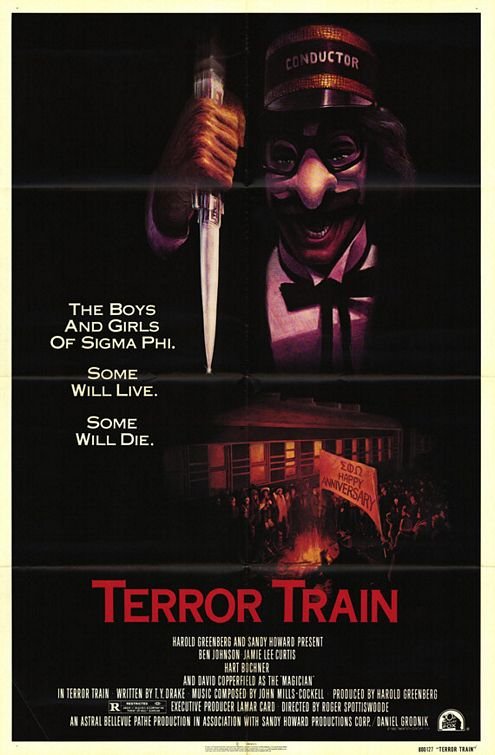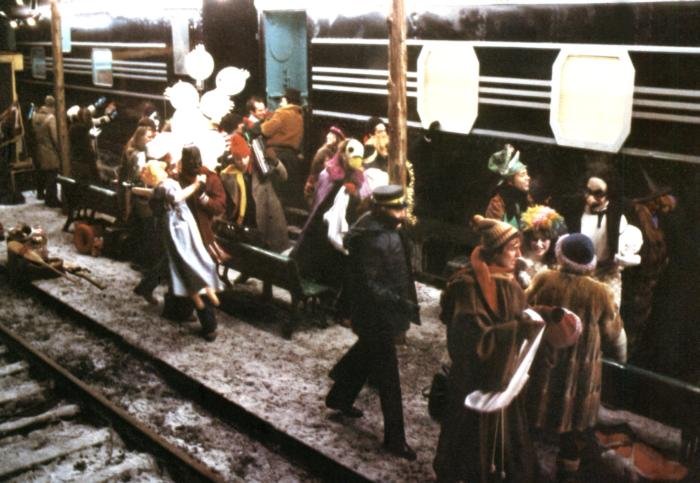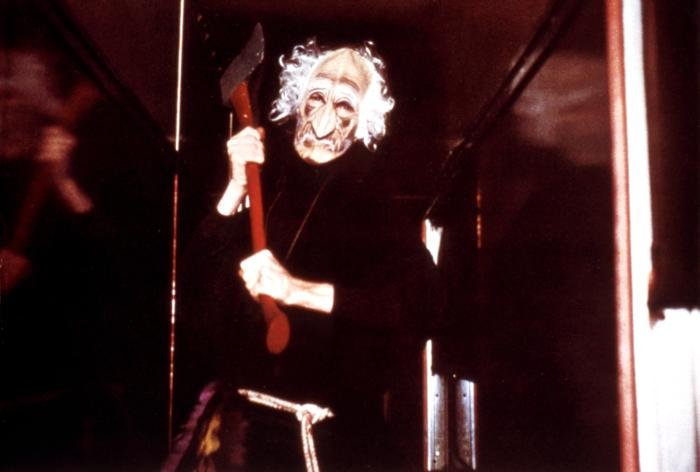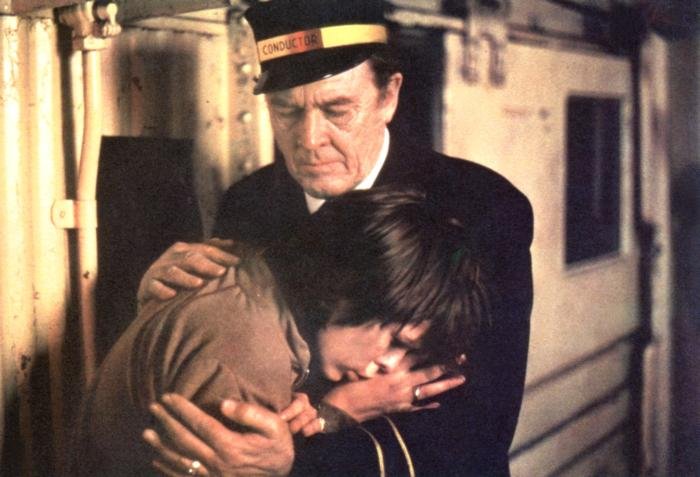TERROR TRAIN: Murder On The Tax-Shelter Express
When slasher movies became a commercial proposition, the Canadian film business went into overdrive to fill that demand. 1980 alone saw the production or release of a triptych of Canuck-slasher items: Prom Night, Happy Birthday To Me and Terror Train. All three became big box-office hits in the U.S. and enduring cult items with slasher movie cultists. Of the three, Terror Train is intriguing because it is the most prototypical of the bunch - and a close look at it reveals the slasher movie's strengths and pitfalls co-existing under one roof. Like many a slasher film, Terror Train begins with a "prank gone wrong" prologue: in this case, sorority pledge Alana (Jamie Lee Curtis) has to earn her keep by participating in a prank against virginal frat pledge Kenny (Derek MacKinnon). She lures him up to a bedroom under false sexual pretenses - but neither knows that the gag involves Kenny ending up in bed with a dissected cadaver. Alana looks on in horror as Kenny has the kind of freak-out that suggests he'll never recover.Cut to three years later as Alana gets on an "excursion train" run by kindly conductor Carne (Ben Johnson) for a fraternity/sorority costume party. Also on board are her beau Mo (Timothy Webber) and Doc (Hart Bochner), a wealthy frat leader who also spearheaded the nasty prank of three years past. The evening starts nicely, with some disco dancing and some tricks from a magician (David Copperfield!), but things get ugly when a killer starts bumping off students. Even when the potential
Like many a slasher film, Terror Train begins with a "prank gone wrong" prologue: in this case, sorority pledge Alana (Jamie Lee Curtis) has to earn her keep by participating in a prank against virginal frat pledge Kenny (Derek MacKinnon). She lures him up to a bedroom under false sexual pretenses - but neither knows that the gag involves Kenny ending up in bed with a dissected cadaver. Alana looks on in horror as Kenny has the kind of freak-out that suggests he'll never recover.Cut to three years later as Alana gets on an "excursion train" run by kindly conductor Carne (Ben Johnson) for a fraternity/sorority costume party. Also on board are her beau Mo (Timothy Webber) and Doc (Hart Bochner), a wealthy frat leader who also spearheaded the nasty prank of three years past. The evening starts nicely, with some disco dancing and some tricks from a magician (David Copperfield!), but things get ugly when a killer starts bumping off students. Even when the potential  victims figure out what's happening, the fact that everyone is wearing disguises ensures the killer won't be easily found.Terror Train isn't a bad film - there are plenty of truly awful slashers that deserve that label - but it's also a film that is difficult to get too excited about. The storyline is boilerplate slasher-movie material: there is the occasional novel wrinkle, like the killer switching costumes as the murders are committed, but thin characterizations and a low number of potential suspects ensure that it is never too involving or suspenseful. As a result, the
victims figure out what's happening, the fact that everyone is wearing disguises ensures the killer won't be easily found.Terror Train isn't a bad film - there are plenty of truly awful slashers that deserve that label - but it's also a film that is difficult to get too excited about. The storyline is boilerplate slasher-movie material: there is the occasional novel wrinkle, like the killer switching costumes as the murders are committed, but thin characterizations and a low number of potential suspects ensure that it is never too involving or suspenseful. As a result, the  middle of the film drags. The direction by former Sam Peckinpah editor Roger Spottiswoode is competent but low on energy or stylistic flourishes. It's also pretty low on visceral thrills, with minimal blood and several kills happening off-screen entirely.On the other hand, Terror Train has a level of professionalism that keeps it from drifting into bad-movie territory. For starters, the acting by the leads rises above the material. Curtis earns her money in the lead role, revealing why she was once a top-shelf scream queen: she never condescends to the material and gives it a level of charm and emotional
middle of the film drags. The direction by former Sam Peckinpah editor Roger Spottiswoode is competent but low on energy or stylistic flourishes. It's also pretty low on visceral thrills, with minimal blood and several kills happening off-screen entirely.On the other hand, Terror Train has a level of professionalism that keeps it from drifting into bad-movie territory. For starters, the acting by the leads rises above the material. Curtis earns her money in the lead role, revealing why she was once a top-shelf scream queen: she never condescends to the material and gives it a level of charm and emotional  investment that other actresses wouldn't bother with. Similarly, Johnson lends a touch of old-school class as the conductor and Bochner does well as the sneering frat-boy jerk, making his character someone you want the killer to meet up with.Along the same lines, it's worth noting that Terror Train has some serious technical prowess. It was photographed by John Alcott, who had just shot The Shining for Stanley Kubrick, and he takes advantage of the train's claustrophobic confines for suspenseful staging. There's also a strong "blood and thunder" musical score that gives the shock
investment that other actresses wouldn't bother with. Similarly, Johnson lends a touch of old-school class as the conductor and Bochner does well as the sneering frat-boy jerk, making his character someone you want the killer to meet up with.Along the same lines, it's worth noting that Terror Train has some serious technical prowess. It was photographed by John Alcott, who had just shot The Shining for Stanley Kubrick, and he takes advantage of the train's claustrophobic confines for suspenseful staging. There's also a strong "blood and thunder" musical score that gives the shock  sequences plenty of sturm und drang. When Spottiswoode's direction connects with these elements, the results can pack a charge. He uses them well during the beginning and ending sequences, with one major highlight being an effective scene where the killer torments Curtis while she's trapped in a cage-like conductor's office.In short, Terror Train is mid-level slasher movie fare. Those who aren't nostalgic for the slasher movie era probably won't get its appeal but if you are into this subgenre of the horror film, there's just enough elements of interest to keep you involved.
sequences plenty of sturm und drang. When Spottiswoode's direction connects with these elements, the results can pack a charge. He uses them well during the beginning and ending sequences, with one major highlight being an effective scene where the killer torments Curtis while she's trapped in a cage-like conductor's office.In short, Terror Train is mid-level slasher movie fare. Those who aren't nostalgic for the slasher movie era probably won't get its appeal but if you are into this subgenre of the horror film, there's just enough elements of interest to keep you involved.


